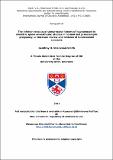Files in this item
Ephedrine requirements are reduced during spinal anaesthesia for caesarean section in preeclampsia
Item metadata
| dc.contributor.author | Clark, V. A. | |
| dc.contributor.author | Sharwood-Smith, Geoffrey H. | |
| dc.contributor.author | Stewart, A. V. G. | |
| dc.date.accessioned | 2011-04-13T09:05:30Z | |
| dc.date.available | 2011-04-13T09:05:30Z | |
| dc.date.issued | 2005-01 | |
| dc.identifier.citation | Clark, V.A., Sharwood-Smith, G.H. and Stewart, A.V.G. 2005. Ephedrine requirements are reduced during spinal anaesthesia for caesarean section in preeclampsia. International Journal of Obstetric Anesthesia. 14(1): 9-13 | en_US |
| dc.identifier.issn | 0959-289X | en_US |
| dc.identifier.uri | https://hdl.handle.net/10023/1815 | en_US |
| dc.identifier.uri | https://hdl.handle.net/10023/1818 | |
| dc.description | Part of the Portfolio Thesis by Geoffrey H. Sharwood-Smith: The inferior vena caval compression theory of hypotension in obstetric spinal anaesthesia: studies in normal and preeclamptic pregnancy, a literature review and revision of fundamental concepts, available at http://hdl.handle.net/10023/1815 | en_US |
| dc.description.abstract | Background: Despite controversy over the haemodynamically safest blockade for caesarean section in women with severe preeclampsia, an increasing number of anaesthetists now opt for spinal anaesthesia. In a previous study we found that spinal compared to epidural anaesthesia offered an equally safe but more effective option for these patients. The current study was designed to compare the hypotension induced by spinal anaesthesia, as measured by ephedrine requirement, between 20 normotensive and 20 severely preeclamptic but haemodynamically stabilised women. Method: Standardised spinal anaesthesia was instituted and ephedrine was given in boluses of 6 mg if the systolic pressure fell >20% from the baseline, or if the patient exhibited symptoms of hypotension. Results: The mean ephedrine requirement of the normotensive group (27.9 ± 11.6 mg) was significantly greater (P < 0.01) than that of the preeclamptic group (16.4 ± 15.0 mg). Conclusion: This suggests that the hypotension induced by spinal anaesthesia in women with severe but haemodynamically stabilised preeclampsia, is less than that of normotensive patients. | en_US |
| dc.format.extent | 5 | |
| dc.language.iso | en | en_US |
| dc.publisher | Elsevier Ltd. | en_US |
| dc.relation | Sharwood-Smith, Geoffrey H. 2011. The inferior vena caval compression theory of hypotension in obstetric spinal anaesthesia: studies in normal and preeclamptic pregnancy, a literature review and revision of fundamental concepts [Thesis]. University of St Andrews | en_US |
| dc.relation.ispartof | International Journal of Obstetric Anesthesia | en_US |
| dc.relation.ispartof | The inferior vena caval compression theory of hypotension in obstetric spinal anaesthesia: studies in normal and preeclamptic pregnancy, a literature review and revision of fundamental concepts | en |
| dc.rights | Copyright (c)2004 Elsevier Ltd. Deposited as part of portfolio thesis by permission of the publisher. | en_US |
| dc.subject | Anaesthesia | en_US |
| dc.subject | Preeclampsia | en_US |
| dc.subject | Obstetric anaesthesia | en_US |
| dc.subject | Spinal anaesthesia | en_US |
| dc.subject.lcc | RG | en_US |
| dc.subject.lcsh | Anesthesia in obstetrics | en_US |
| dc.title | Ephedrine requirements are reduced during spinal anaesthesia for caesarean section in preeclampsia | en_US |
| dc.type | Journal article | en_US |
| dc.description.version | https://doi.org/Publisher PDF | en_US |
| dc.publicationstatus | Published | en_US |
| dc.status | Peer reviewed | en_US |
| dc.identifier.doi | https://doi.org/http://dx.doi.org/10.1016/j.ijoa.2004.08.002 | |
| dc.format.type | text |
This item appears in the following Collection(s)
Items in the St Andrews Research Repository are protected by copyright, with all rights reserved, unless otherwise indicated.

